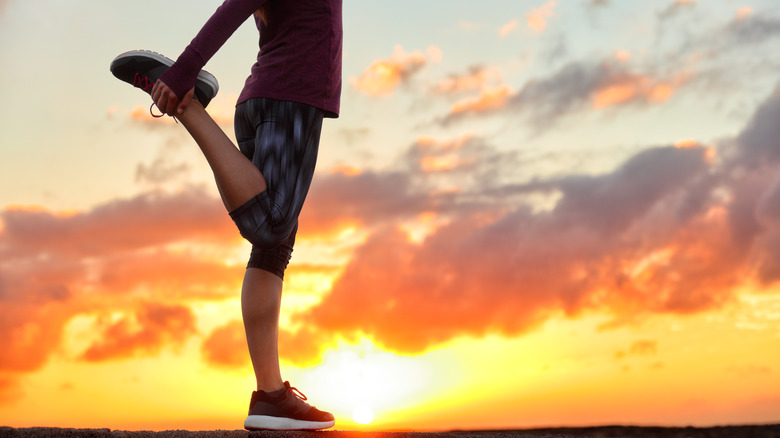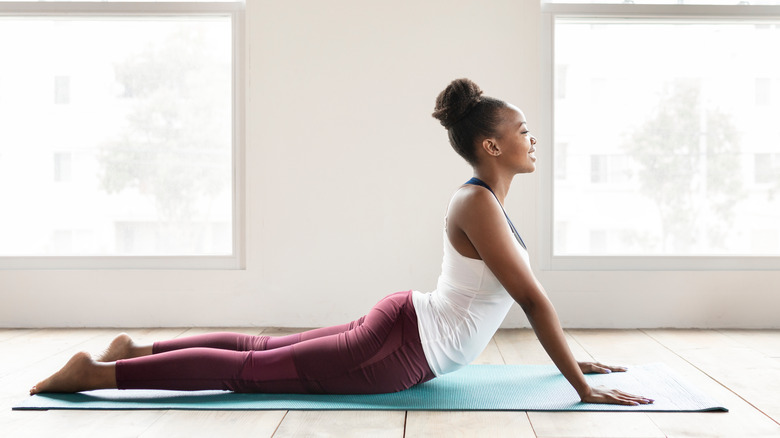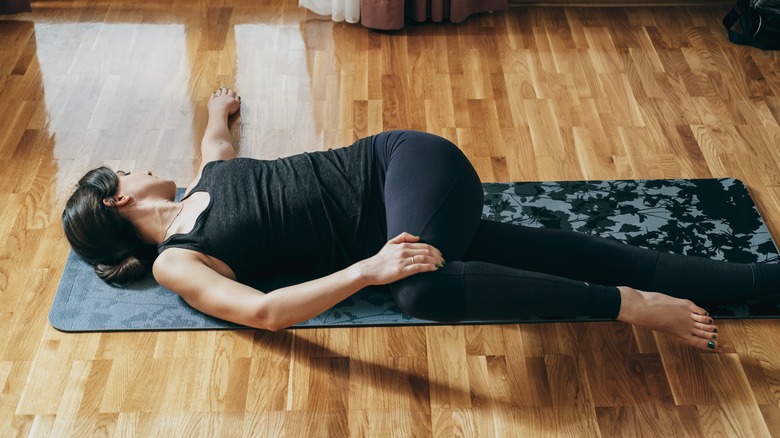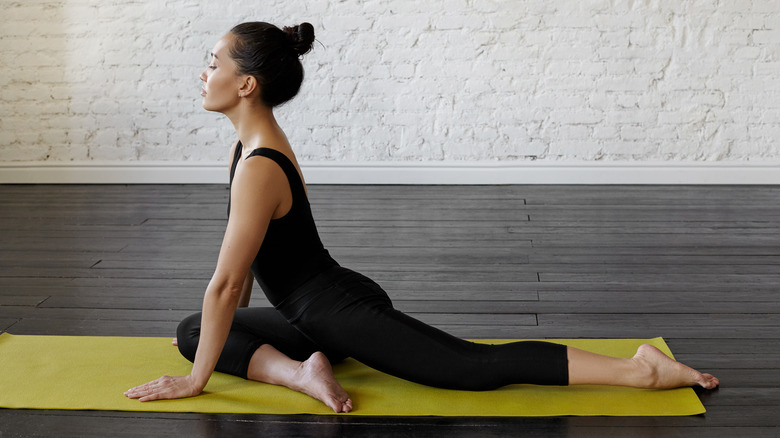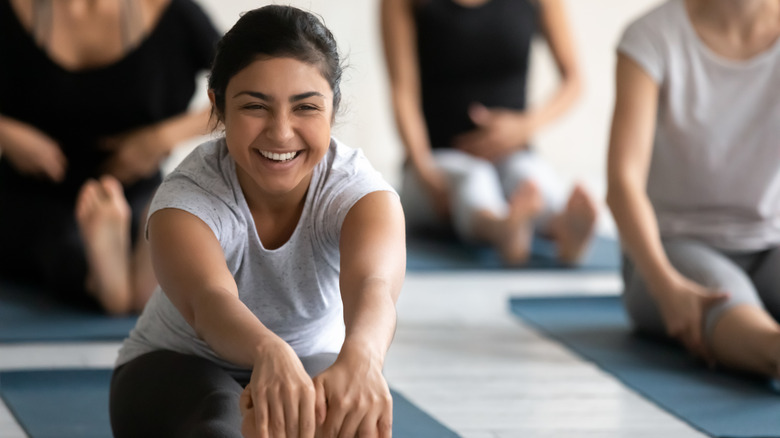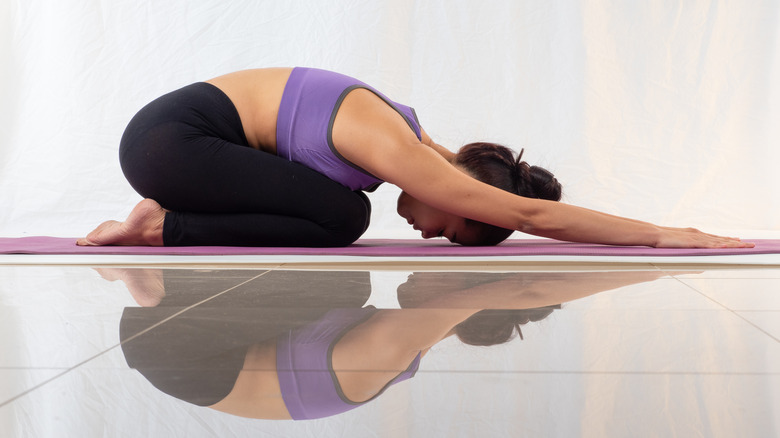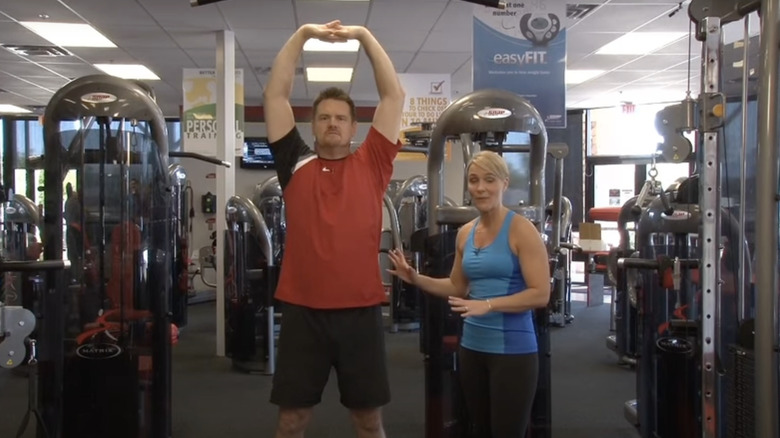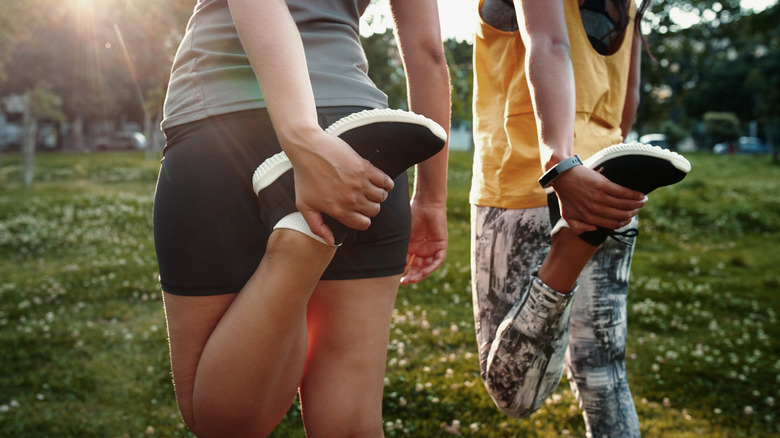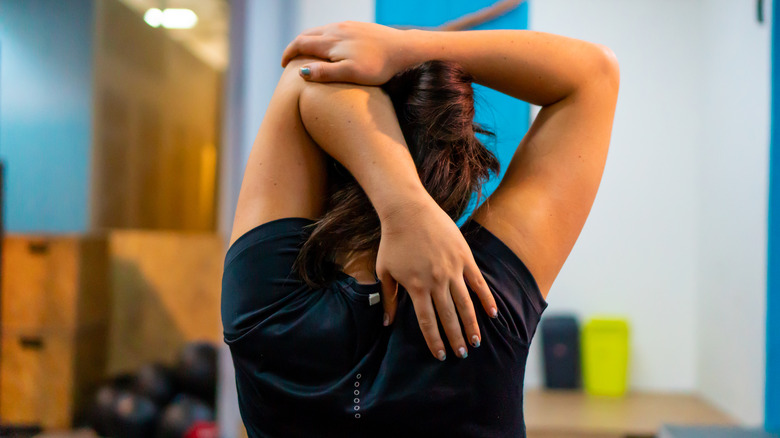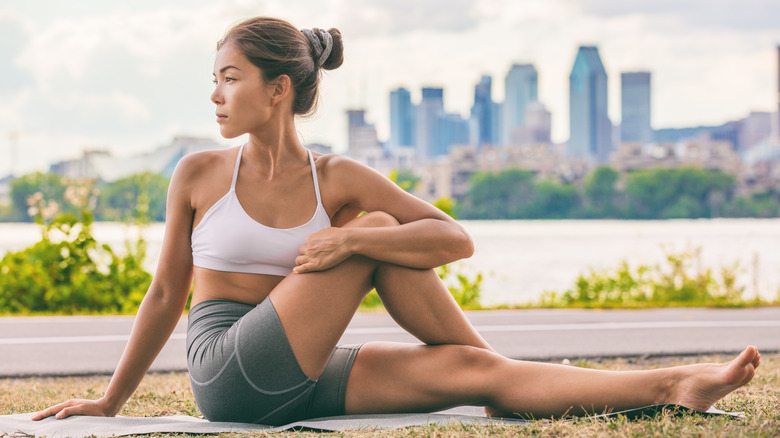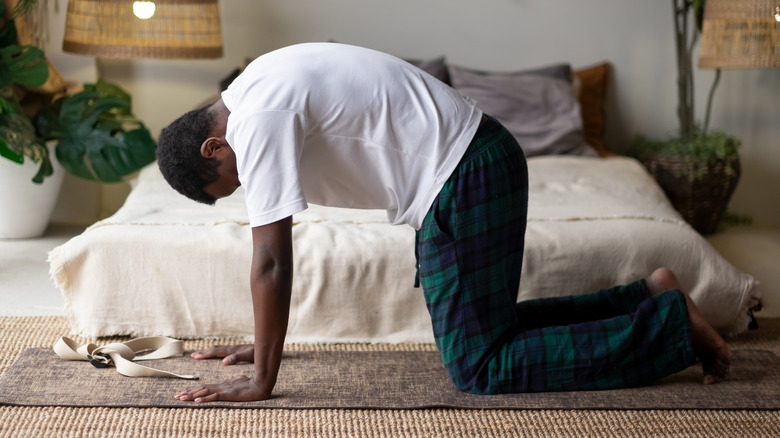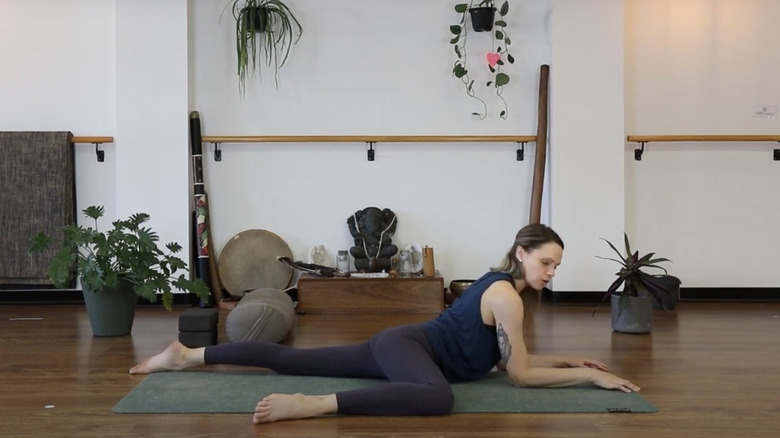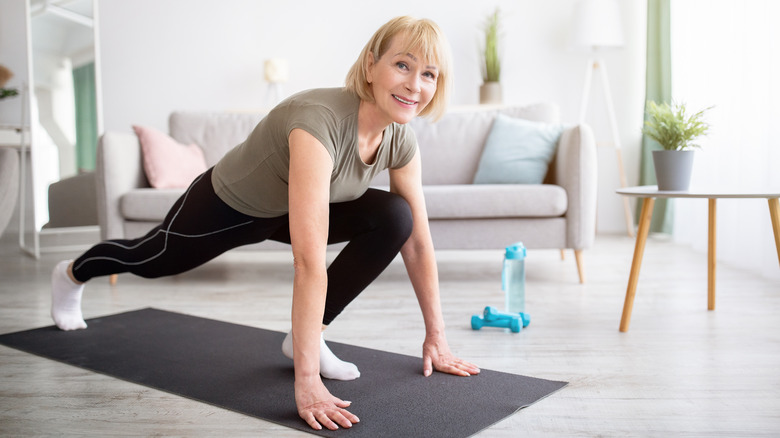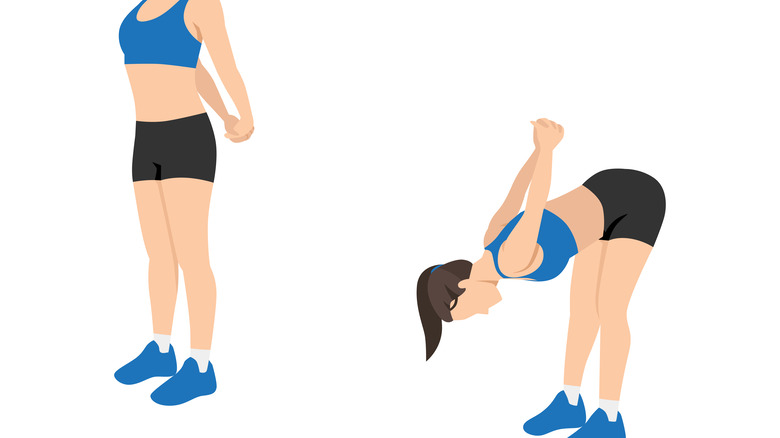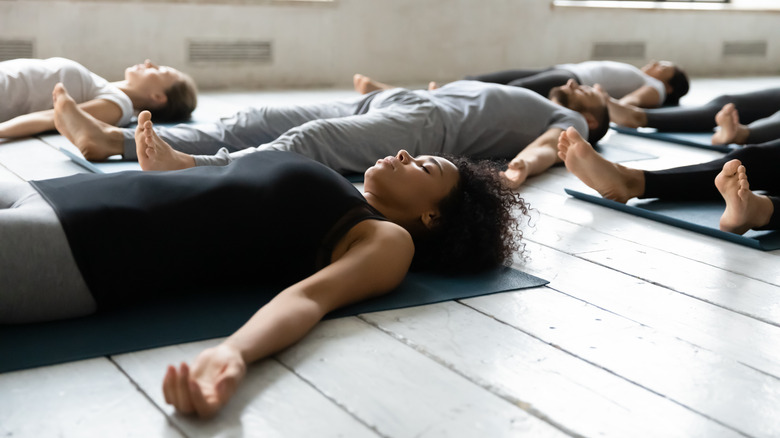The Best Cool Down Stretches To Do After A Workout
So, you've just finished a killer workout. Congratulations! You nailed it, and we're proud of you, superstar! But before you put your feet up and bask in that post-exercise glow, there's just one more thing you have to do: cool down. Your body is a little like a car, and when you've been driving it at high speed during a workout, gently slowing it back down to a resting state helps to regulate it, advises Boom Cycle trainer Lisa Jane Holmes via Men's Health. And the best way to do that is with a stretching routine.
Stretching post-workout will not only reduce the amount of lactic acid that collects in your muscles but will also "help to reduce muscle stiffness and soreness in the next 24 to 48 hours after your session, as well as helping to maintain joint flexibility," Holmes says. And the best part is, your muscles are already prepped and warm after your workout — meaning that you'll get an even deeper stretch, thereby benefitting your flexibility.
But there are a million and one stretches to choose from, and you don't have all day, right? We hear you. That's why we've put together our top picks of cool down stretches, so you can get your body back to stasis safely, quickly, and effectively.
Core abdominal stretch
No matter what you're doing, it's likely that you're using your abs. The core muscles are involved in a huge number of workouts and exercise moves, and are "key to good workouts and the health of your lower back," says Callista Costopoulos Morris, Geisinger Musculoskeletal Institute's sports orthopedic surgeon (via PureWow). This stretch is also a fantastic choice after a round of crunches and sit-ups, helping to extend the ab and oblique muscles and enabling them to begin their recovery.
Start by lying face-down on an exercise mat, with your hands placed gently on the floor at shoulder height. Your feet should be pointed behind you, with the tops of your feet flat on the floor. Press your hands into the mat, bringing your upper body off the ground and generating a stretch through your core muscles. However high you're able to go in this position is down to your flexibility, but even a small elevation off the floor will give you a core stretch. Bring your head back and your gaze above you, and hold the position for around 30 seconds, before gently lowering yourself back to the mat and resting.
Lying spinal twist
In any workout, your spine gets a lot of action, and you must tend to it. One of the best ways to do this is with a lying spinal twist. This stretch has a wealth of benefits, stretching out and lengthening your spine as well as your quadriceps, and also gives your hips and back a little bit of love, according to The Art of Living.
Begin by lying on a yoga mat, with your legs flat on the floor and fully extended, and your arms by your side, explains Coach. Bend one of your legs, and then allow it to drop over your extended one, crossing over your body. Place your opposing arm on the outside knee of your bent knee, pressing it gently, feeling the twist through your spine. Keep your shoulders connected to the ground, avoiding the temptation to let them lift up. Turn your head in the opposite direction to your knee, keeping your gaze steady. Breathe into the stretch here, holding it for up to 30 seconds or longer, before releasing and resting.
Pigeon pose
Ah, pigeon pose. So beloved by yoga instructors, and so feared by the people taking an instructor's class — it goes pretty hard on the stretching front. But while pigeon pose may be a slightly more advanced move, there's no denying how effective it is. And with its hip-opening and thigh-stretching benefits, it's easy to see why it takes pride of place in cool down routines, states certified personal trainer Stephanie Mansour via Today.
Grab a yoga mat, and move into a downward-facing dog position, with your body arched and your hands placed flat on the floor. Lift one of your legs, and bring it forward, resting it bent on the ground in front of your body. If you can, your leg should be in a 90-degree bend, with your lower leg horizontal on the mat in front of you. Gently lower your hips down, feeling the stretch through your glute and your thigh, while your back leg remains straight behind you, with your foot flexed. Ensure that your hips aren't rotating. Breathe into the stretch here, hinging forward at the hips and placing your elbows on the ground in front of you, if you want a deeper stretch. Hold the pose for up to a minute, before releasing your front leg and resting.
Seated forward bend
Tight hamstrings are an issue that affect a lot of people, and a good hamstring stretch post-workout can help combat this. A seated forward bend is one of the most effective movements for your hamstrings, lengthening them out while also providing a stretch through the spine, Spotebi explains. Sit down on the floor, with your legs flat in front of you, and your feet placed together. Take a deep breath in, and as you breathe out, gently hinge at the hips, bringing your upper body toward your quads. Make sure that your spine remains long here, and doesn't bend too much or crunch inward. Reach your hands forward, grabbing your feet if possible, and breathe into the stretch, for a total of one minute before releasing and resting.
Remember that proper form is essential with the seated forward bend. If you introduce too much of a curve into your lower back, it may cause strain, advises yoga instructor Joan Hyman via Livestrong. As such, those with lower back issues may want to find an alternative hamstring stretch, such as a wall hamstring stretch (per Spine-Health).
Child's pose
It's easy to think of a child's pose as a resting position, and there's no denying that it's deeply relaxing (especially at the end of a much-harder-than-you-thought yoga workout). But importantly, it's also a stretch. Child's pose is "a great way to stretch the small muscles in your back that connect your vertebral bodies (the larger bones that make up your spine)," says Callista Costopoulos Morris, sports orthopedic surgeon, (via PureWow). Doing a child's pose can also create more space between your vertebrae and the nerves between them.
Begin by kneeling on your yoga mat, with your hands placed on the ground underneath your shoulder joints. Lean your body back, and allow your butt to drop down toward your calves. It can be helpful to widen your knees slightly as you do this or to place a cushion on your calf muscles if your glutes can't extend back. Bring your head toward the mat, and keep your hands connected to the ground, so that you generate a stretch through your back. Hold the position here for around 30 seconds or so, breathing deeply into your belly as you do so. Finish by raising your body back up to a kneeling position to rest.
Overhead reach
We encourage you to spare a thought for your forearms. "The forearm is easily one of the more overlooked body parts that requires stretching," says Joshua Margolis, certified personal trainer (via The Healthy). In a workout that requires any form of gripping whatsoever, your forearms are going to be used, and incorporating forearm stretches into your cool down routine keeps them healthy and happy.
For a simple forearm stretch that hits both of them at the same time, try the overhead reach. Stand up straight, and extend both of your arms above your head. When they're both straight, lace your fingers together, turning your hands as you do so, so that your palms are facing toward the sky. Breathe out, and push your hands up, which should activate a stretch through the inside of your forearm, which controls your wrist extension. Hold the stretch for up to 30 seconds, before releasing your hands and resting. Then, repeat the stretch a few more times. You can also do this stretch in a seated position — just ensure that your upper body's not collapsing in on itself as you do so.
Standing quad stretch
If you're a runner, you'll likely know how important stretching is. As you run, lactic acid can build up in your muscles, and stretching after activity helps to dissipate the acid, making your recovery easier while simultaneously easing your heart rate back down to a resting pace (per Yale Medicine). Your quad muscles are heavily involved during a run and will need a little lovin' after you've hit the track, making the standing quad stretch an ideal movement to perform post-jog.
Stand with your feet shoulder-width apart, and shift your weight onto one leg, explains Healthline. Lift your other leg off the floor, bending it backward, and grab your ankle with your hands. You should feel a stretch through the front of your thigh (i.e., your quad muscle). Keep your knee tucked in, making sure that it doesn't flare out to the side. If it's easier, you can extend one of your arms out to balance yourself or hold onto a chair with one hand while you do this stretch. Hold the position for approximately 30 seconds before releasing your leg, and bring it back to the floor, before repeating the stretch with the other leg. Ideally, you'll stretch each leg up to three times.
Overhead shoulder stretch
One of the best things about stretching is that seemingly simple movements can cover multiple muscle groups. This is definitely the case with the overhead shoulder stretch. As well as stretching out your shoulder (as you might expect, given its name), the overhead shoulder stretch also works through your tricep muscles and stretches some of your back, making this a multi-functional movement ideal for a cooldown (per Prevention).
Start in a standing position, or sitting on an exercise bench, and then bring both of your arms above your head. Bend one of your arms, and place it on the top of your back. Your other hand should be placed lightly but firmly on your bent arm's elbow. Don't let your shoulders bunch up to your ears here — they should still be relaxed. While breathing out, press your elbow, introducing a stretch through your upper body. Continue to breathe as you hold the stretch for roughly 30 seconds, before releasing your arms and mirroring the stretch on the other side of your body.
Piriformis stretch
For a small muscle, the piriformis sure does a lot. Located in your butt among your gluteal muscles, the piriformis is involved with rotating the hips and leg, according to Spine-Health. But the piriformis is also nestled next to the sciatic nerve, and if that nerve becomes aggravated or inflamed — or if the muscle starts to spasm — it can become squashed, resulting in a condition called sciatica that can create pain through the legs and lower back (per PureWow).
One of the best ways to combat and prevent sciatica is through stretching the piriformis, particularly post-workout. Sit yourself down on the floor, with your legs extended in front of you, and both hands placed on the floor behind your back. Bend one of your legs over the other, and then take the elbow of the opposing arm, and place it on the outside of the bent leg's knee. Facing your palm inward, and operating a pushing motion, can deepen the stretch here. Twist your body outward, sort of away from your bent leg, and cast your eyesight over your shoulder as you breathe into the stretch. Hold this position while continuing to breathe, before releasing the stretch and returning to a regular sitting position.
Cat-cow stretch
It's hard to think of a stretch that we love more than a cat-cow. This simple movement uses two positions to stretch the front and back of the upper body, with engagement through your spine, abs, back, hips, and neck muscles (via Prevention), while you also get to role play being your favorite animals. Well, ours anyway!
Begin by getting onto all fours, with your limbs aligned with your joints. Then, breathe in, and allow your belly to drop toward the floor, arching your back as your head moves up and back. This is the "cow" position, in which you should feel a stretch through the front of your body. Remain in this position for a second or two, and then breathe out, and round your back, with the center of it moving toward the ceiling. Your head should drop down naturally, your gaze going toward the floor. This is the "cat" part of the movement, which delivers a stretch through your back and spine. Again, hold the position briefly, and then move back through to the "cow" pose, alternating between the two for as long as you like. Whatever you do, though, don't rush the stretch: Take your time, and enjoy it!
Half-frog with thoracic spine stretch
While the word "half-frog" might conjure images of unlucky amphibians soon to be served up on a gourmet restaurant plate, we can assure you that no frogs were harmed in the conception of this stretch. Half-frog actually refers to the position of your legs while doing it. And this stretch — aside from allowing you to imagine living in a pond — is also fantastic for your thoracic area, the upper-middle portion of your spine that's involved in lifting, twisting, and shock absorption, with thoracic mobility important to keep your workouts effective (per Healthline). Having your legs in half-frog also stretches out your hips, lower back, and butt, according to Tummee.
Start by lying face-down on a mat, with your head turned to the left side, and your arms outstretched to either side of your body, palms flat on the floor, according to Women's Health. Take your right leg, and bend your knee, keeping it connected with the floor until your thigh's perpendicular to your upper body. Simultaneously push your hands into the ground, and your hip into the floor below you, holding the stretch for up to one minute. Return your leg to the original position, turn your head to the other side, and repeat with the opposite leg.
Runner's lunge
When it comes to stretching your lower body, few exercises are better than a runner's lunge. Runner's lunges are particularly useful after workouts that focus on the hips, thanks to their ability to stretch the groin, hip flexors, and hip muscles (per Get Healthy U). This can then aid in the recovery of your muscles.
To do a runner's lunge, begin by moving into a high plank. Your arms should be outstretched beneath your shoulders, with a straight line from your heels to your head. From here, lift one of your legs, and step it through, planting it in between your hands. Allow your hips to then drop toward the floor (it can be tempting to try and keep them elevated, but the real stretch comes from letting things sink as much as possible). You can keep your back knee and leg elevated, or let your knee drop to the floor as well. Continue to breathe into the stretch, keeping your neck relaxed and your gaze steady, before picking your front foot back up and moving it back, so you're back in a high plank. Rest here, and then repeat the stretch on the other side.
Biceps stretch
The biceps are one of the easiest muscles to isolate during training, but we mustn't forget how involved they are in a range of other exercises. Bent-over rows, resistance band pulls and curls, and chin-ups all activate your biceps (per Barbend), and if your workout has involved any curling action whatsoever, you'll want to include a biceps stretch in your cooldown.
A behind-the-body biceps stretch also has the added benefit of stretching out your chest and shoulders. Stand upright, with your back straight, and then hold your hands together behind your back, interlacing your fingers (per Spotebi). Gently turn your hands over, so that your palms are facing the ground, and ensure that your arms are straight, without locking your elbows. Then, raise your arms behind you. As you do so, your upper body should start to naturally bend at the hips. Keep raising your arms until your body's at a 90-degree angle, with your palms facing the ceiling above you. Continue to breathe deeply, avoiding the temptation to bounce or to bend your back, as both of these things can result in strain or injury. Hold the stretch for up to 30 seconds, then return your body to standing and release your hands.
Corpse pose
Of all the cool down stretches to incorporate into your routine, this is probably our favorite. Why? Well, after a hard workout, what's better than lying on the floor doing not very much at all? Corpse pose, while not strictly a stretch, is an excellent opportunity to allow your body to cool down post-exercise, and to consciously relax your body, allowing your muscles to release tension (per Tummee). It's particularly beneficial for folks who hold tension in the lower back during exercise.
To do a corpse pose, grab your yoga mat, and lie down on the floor, face-up, explains Healthline. Your feet should be at a natural distance, just a little wider than your shoulders and hips, and your palms should be facing the ceiling. Allow your toes to rock gently outward to each side. Then, with each breath out, permit your body to relax even more, letting go of any points of tension. It can help to think of your body sinking deeper and deeper into the ground on each exhale. You can also close your eyes if you wish. Remain in corpse pose for up to five minutes, before gently pulling yourself back up to sitting, making sure you don't move too quickly. Now, wasn't that nice?

